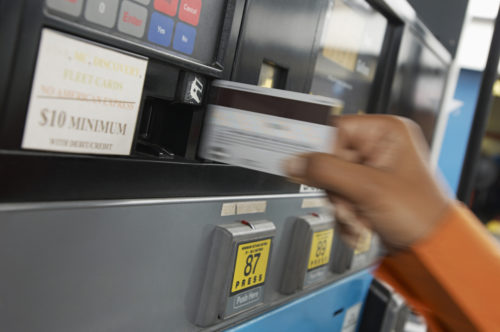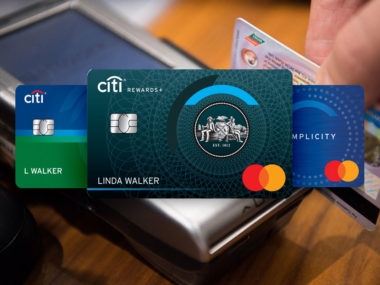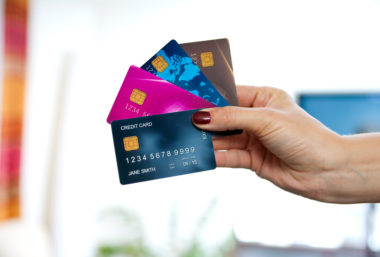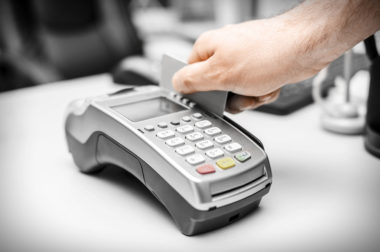If you own a car, then you have to budget for fuel every month. Depending on where you live and how much you drive, this can be a major expense — in some places, well over $100 per month. In fact, by some estimates, Americans spend even more at the pump, dropping close to $400 every month to put gas in their cars.
Because gas prices fluctuate so often, and in some cases have hit the $3 per gallon mark (or even higher), the idea of getting a gas station credit card might be appealing. Many gas station cards offer per gallon discounts and other rewards to entice consumers, but before you sign up, it’s important to understand exactly what you get with a gas card, and how it can affect your credit and finances.
Table of Contents
What Is a Gas Credit Card?
A gas station credit card is just what it sounds like: a credit card that can only be used at one chain of gas stations. Often, the card is also valid in attached convenience stores, making it possible to fill your tank and grab a snack or a cup of coffee and put it all on the card. It’s not a prepaid card loaded with a specific dollar amount to spend, but rather a line of credit that you need to repay as you use it.
Most gas station credit cards offer some type of perk or rewards. These range from discounts on fuel purchases (e.g., 5 cents off every gallon or 10 cents off when you reach a certain spending threshold) to rewards based on your spending. Depending on the brand, you might also receive other benefits, such as free or discounted car washes or special offers in the attached convenience store.
The discounts on gas and rewards for spending are meant to keep customers loyal to the gas station brand, rather than just stopping at the first station they find or shopping around for the lowest prices. When used strategically, they can be beneficial to your budget, but there are some drawbacks.
Examples of Gas Credit Cards
Most major gas station chains offer their own branded credit cards. Regional chains may also offer their own cards. For example, you can apply for a credit card with:
- ExxonMobil;
- Shell;
- Gulf;
- Chevron;
- Speedway;
- Sheetz;
- BP;
- Valero;
- Lukoil;
- Irving;
Many of these brands offer both store-specific cards, which can only be used for gas purchases, as well as a branded Mastercard or Visa, which can be used anywhere to earn gas rewards on all of your purchases. Rewards programs vary considerably between cards as well. The Shell Card gives a 5 to 10 cent per gallon discount when you pay with the card, while the BP card offers a 5 cent per gallon discount when you buy gas at their stations; that discount jumps to 10 cents when you use the BP Visa.
How to Get a Gas Credit Card
Like many store credit cards, gas station credit cards tend to be easier to get when you have less-than-perfect credit than general rewards credit cards. Most lenders will approve your application if you have at least a fair credit score (600 or above), so a gas credit card can be a good choice if you’re looking to build your credit or repair a not-so-great credit history.
Getting a more general gas station branded rewards card, such as the ExxonMobil Visa, often requires a higher credit score (in the good range, or 690 or better). You can apply for a gas station credit card online or by filling out an application available at the gas station.
Where Can You Use a Gas Card?
Unless you get a gas station branded general rewards card (e.g., Mastercard, Visa, or American Express) you can usually only use a gas credit card at that chain’s locations. This includes paying for fuel at the pump or inside the store. You may also be able to use the card for purchases inside the store or for other services at the gas station, or to get a cash advance from an ATM.
If you opt for a gas station branded rewards card, you can use that card anywhere it’s accepted. You’ll earn rewards for all purchases, but typically you earn rewards at a higher rate for purchases at the gas station.
How Do Gas Rewards Work?
Not all gas station credit card rewards programs are created equal, and how you use your card can significantly impact your rewards earnings. In general, gas station credit cards offer a discount on your purchases at the pump, but how they do that varies wildly.
Some might offer a flat discount per gallon when you use the card, with the per-gallon savings increasing as you spend. Some may provide a discount based on a percentage of your spending; for example, you might earn 1% to 3% cash back on gas purchases, or points that can be applied to future purchases for a discount.
Because these programs vary so much, and the stipulations for earning rewards can be complex, it’s vital that you carefully review the terms and conditions of any card before submitting an application. Some of the most common stipulations include:
- A requirement to purchase a specific number of gallons of gas before the rewards kick in (for example, you might qualify for rewards only after you purchase 50 gallons of gas in a month).
- Limits on how many gallons you can purchase at a discount each month.
- Different levels of earnings based on how much you spend or how many gallons you purchase.
- Introductory offers that only apply for a short time (i.e., a big discount on your purchases in the first three months, followed by less generous discounts).
Of course, there’s also another big stipulation with gas station credit cards: the interest rate. Like other store credit cards, gas credit cards often come with high-interest rates. The ExxonMobil Smart Card and Shell Fuel Rewards Card, for instance, charge a 27.99% annual percentage rate for purchases and 29.99% for cash advances. Shell also offers a Fuel Rewards Mastercard with the same interest rate.
How to Best Use a Gas Card
Despite the high-interest rates, if you pay your balance in full each month, a gas station credit card can save you a little bit of money at the pump. Depending on the rewards offered, if you average about 100 gallons of gas per month, you can save about $5 to $10 or more on gas purchases.
Saving money at the pump isn’t the only benefit of a gas card, though. Some of the other high points include:
- The ability to pay for gas without using your debit card or cash at the station. If you typically pay at the pump, this may be a safer option, as gas cards tend to have lower limits than other cards, and you won’t be exposing your credit card or bank account to criminals if the card reader is compromised.
- The ability to more closely track your fuel purchases for budgeting. This is especially useful for those who drive for work.
- Easy to get and use to establish or rebuild credit.
- Big signup bonuses that can help you save more money in the short term.
However, some of the drawbacks of a fuel card might have you thinking twice. The stipulations placed on rewards can make it complicated to earn and use them, and if you don’t pay the balance in full every month, the interest charges will negate any savings at the pump — and actually make it more expensive to get gas.
Other drawbacks to gas station cards include:
- Station-specific cards can only be used with certain brands. This could mean that you spend more because you feel tied to that particular brand, even when another nearby station is less expensive.
- Cards for regional chains may be useless when you travel (for instance, Sheetz stations are only found in the mid-Atlantic, Ohio, and North Carolina).
- Rewards can only be used with the gas station, or for cash back on gas purchases.
- Some stations charge more per gallon for credit card purchases, even when you use a branded card.
Another thing to consider when looking at gas station credit cards is the fact that many gas station brands offer rewards programs that aren’t tied to a credit card.
For example, ExxonMobil’s Rewards+ program awards points for every gallon of gas purchased (currently 3 points per gallon and 2 points per $1 spent in the store or on car washes) and gives you $1 off your gas purchase for every 100 points you earn. You can also earn extra points by paying through the mobile app or during special earnings periods. Other brands offer similar free rewards programs, which, depending on your driving habits, could potentially earn you even more rewards than a credit card.
Ultimately, to get the most from a gas station credit card you need to get gas at the same chain every time and pay your balance in full every month. For the most flexible rewards, though, and the opportunity to earn on everything you buy, a more general rewards credit card may be the better option.
Image Source: https://depositphotos.com/





